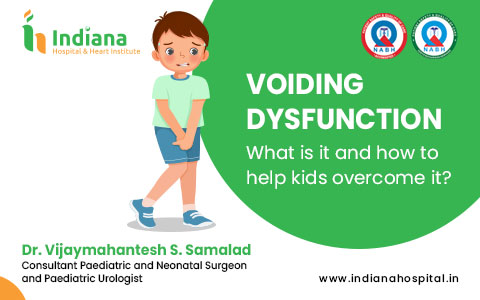Voiding Dysfunction: What is it and how to help kids overcome it?
In the digital era when children are obsessed with electronic toys and television, a condition that occurs commonly but remains under-diagnosed is Voiding Dysfunction.
Children often complain of urgent or frequent urination. A common finding in almost all such children is the occurrence of varying degrees of constipation. It could be a general phenomenon of holding pattern or postponing the acts of evacuation.

At the milder spectrum, they might present as just an urgency, while at the extreme spectrum, they might have total voiding disturbance with incontinence and renal scarring and could be one of the causes of renal failure. Because most of the cases have some association with the disturbances of defecation as well, the recent terminology for these conditions is Bowel Bladder Dysfunction (BBD). These conditions account for nearly 40% of paediatric urology consultations in some centres.
For the simplicity of the discussion, we would call these conditions voiding dysfunction.
Ways of presentation
- Urgency: Hurry for the visit to toilet, failing which, there will be a leak in the undergarments.
- Frequency: Increased visits to the toilet, more than the normal routine visits, often associated with urgency.
- Dysuria: Pain or itching in the genitalia or lower abdomen while passing urine.
- Vaginal voiding: Pooling or collection of urine in the vaginal cavity after the act of voiding. May present itself as wetting of the undergarments in the females after the act of passing urine.
- Hesitancy: Undue delay in the commencement of urination can often be associated with pain in the genitalia at the start of urination.
- Straining while passing urine.
- Night-time or day-time incontinence.
In many children, there is an associated dysfunction with defecation. There is a history of constipation or passing hard stools in almost all of them. There could be a history of accidental soiling of the undergarments with faeces or of alternating constipation and passing loose stools. Anatomical and functional interactions between bladder and bowel are well-established. In general, increased rectal faecal load can affect the bladder function by: a) Mechanical compression – resulting in decreased bladder capacity, causing urgency and frequency or by b) changing the physiological neural stimuli of the bladder leading to a decreased urge to evacuate, causing bladder spasms and pain, insufficient urination and residual urine, leading to an increased risk of urinary infections and renal damage.
Postponement of toilet visits is increasingly observed when children tend to delay urination while they are distracted playing, using electronic toys or watching television. This behaviour often results in holding manoeuvres, low voiding frequency, urgency, and daytime incontinence. Constipation is frequently associated with voiding postponement, as the mechanism to delay defecation is similar. The social stigma of persistent wetting and bowel accidents is a common problem faced by these children and can lead to self-esteem issues, shame, isolation, poor school performance, aggressiveness, and other behavioural changes.
Diagnostic work-up and management:
Diagnostic work-up includes a routine test of urine analysis, an X-ray of the abdomen to assess the amount of faecal loading and renal ultrasound to assess the kidneys, bladder and the amount of residual urine after urination.
Management is primarily behavioural, but if intractable, then medications are advised. Constipation management is an integral part of the treatment. Children should be encouraged to:
- Pass urine regularly – timed every three hours. Children should be encouraged to pass urine in the school recess breaks. Holding the urine is the primary cause of most of the symptoms. School toilets must be maintained hygienically to encourage children to visit during breaks. A general practical recommendation is: “Every two hours try to pee, wash your hands, and have a cup of water.”
- Adequate hydration – depends on the age of children and weight. On average, up to 8 cups per day should be encouraged. Daytime adequate hydration is a must. Most of these children have a reversed pattern of hydration: with decreased adequate intake in the day to avoid toilet visits and compensate it with increased intake after school hours. This should be corrected.
- Constipation Management: Children should be encouraged for a healthy and high fibre diet and should preferably pass stools in the morning completely before resuming schools. In persistent constipation, a course of laxatives or stools softeners are indicated.
- Educational resources: Whenever possible, educational resources must be shared with families. They include the general tips about the proper toilet positioning and posture for passing urine and stools.
- Medications and Surgery: Medication is considered in case of failure to improve after behavioural modifications and control of constipation and in some severe conditions requiring immediate relief. In severe intractable conditions or failure to comply, certain surgical interventions might be required.
In summary, voiding dysfunction is a common but yet under-recognised condition especially in toilet-trained school-going children. Early recognition and prompt therapy prevent these children from social embarrassment with urinary and faecal leaks, and in extreme cases, from severe damage to the renal system and long-term effects.
